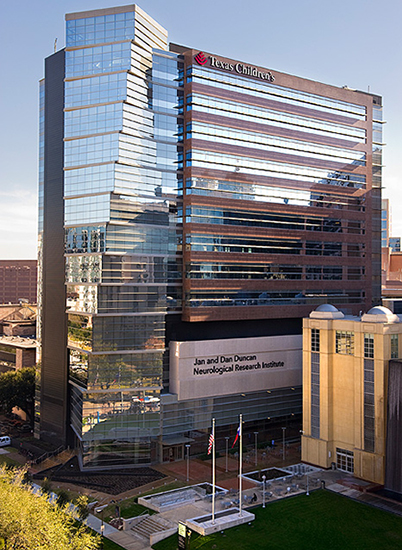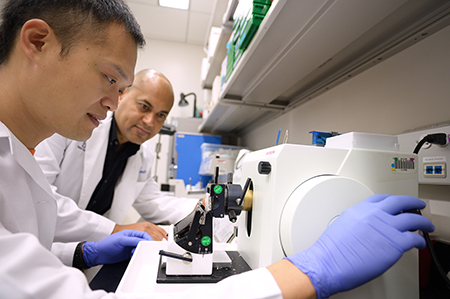Composed of 86 billion neurons and an array of intricate structures, the human brain is a complex organ that regulates every process within the body. Just as we cannot live without a brain, laboratory scientists cannot conduct research without well-designed infrastructure. “Thinking as a neuroscientist, it is hard to overemphasize the importance that a structure has on functionality,” reflected Dr. Juan Botas, Professor in the Departments of Molecular and Human Genetics and Molecular and Cellular Biology at Baylor College of Medicine (BCM). “And that applies not just to the brain, but also to the design and structure of our research facilities.”

Dr. Botas is a member of the Jan and Dan Duncan Neurological Research Institute (NRI), located in Houston, Texas. A collaborative venture between BCM and Texas Children’s Hospital, the NRI focuses on the treatment of diseases and disorders of the brain and mind. The NRI received an ORIP award (C06RR029965) through the 2009 American Recovery and Reinvestment Act (ARRA) grant program, the goals of which were to stimulate the U.S. economy, create and preserve jobs, and advance scientific research. A total of 148 ARRA awards were granted through ORIP to support the construction or renovation of 64 animal facilities, 56 research laboratories, 17 clinical research facilities or laboratories, 8 imaging facilities, and 7 data centers.
Dr. Huda Zoghbi, Director of the NRI and Professor in the Departments of Pediatrics, Molecular and Human Genetics, Neurology, and Neuroscience at BCM, emphasized that every corner of the NRI was carefully designed to enhance its capabilities for investigators and their trainees. The ARRA award enabled the build-out of shell spaces on five floors of the NRI’s 13-story building (Figure 1). Major features of these new spaces include research animal housing rooms, specimen storage areas, specialized procedure rooms, and centralized common areas (Figure 2).
The NRI is home to research in a broad array of areas, including rare neurodevelopmental diseases, neurodegenerative diseases, undiagnosed genetic disorders, multiple sclerosis, glioma, epilepsy, neuropsychiatric diseases, and fetal disorders. Dr. Ben Arenkiel, Professor in the Departments of Molecular and Human Genetics and Neuroscience at BCM, explained that the NRI has enhanced its interdisciplinary culture. “We do everything from cell culture to mouse genetics to in vitro application to in vivo manipulations,” he explained. “It was a huge benefit of the C06 award, designing our lab space here and having the ability to be creative on how we wanted to make the space.”
The NRI’s vivarium was carefully designed to provide researchers the controlled conditions required for rigorous and reproducible animal studies that can be advanced to clinical trials. The facility also includes flexible spaces that house state‑of-the-art technologies for research. The facility’s 10th floor, for example, features a central, open laboratory space that is shared among users. Office spaces for students and postdoctoral fellows are dispersed along the perimeter of the floor in brightly lit areas, encouraging discussions among research groups.

The NRI and its facilities have fostered a culture of success among users at all levels. Over the years, the NRI has grown, serving as a resource hub for other institutions in the Houston area. During this time, the program has maintained its focus on cultivating the next generation of scientists, many of whom go on to successful careers in academic research. The facility has supported the training of numerous graduate and medical students and postdoctoral fellows from BCM, visiting students from other institutions, and medical residents who have an interest in gaining research experience. Dr. Arenkiel explained that every user—from the level of an undergraduate student to the most decorated senior scientist—is treated equally. “No one gets treated as lesser, and I think the students feel that,” he reflected. “They believe they can do anything they set their minds to because they have great examples.
Looking to the future, the team underscored the importance of continued funding for research infrastructure. The facility’s open and flexible design aligns perfectly with NRI’s underlying culture of collaboration and innovation. Modernized facilities are crucial to the advancement of research. “We have had such incredible, positive outcomes from having the facility,” Dr. Zoghbi emphasized. “It’s really providing our trainees the opportunity to perform cutting-edge research.”
Learn more information on the ARRA program and awards.



